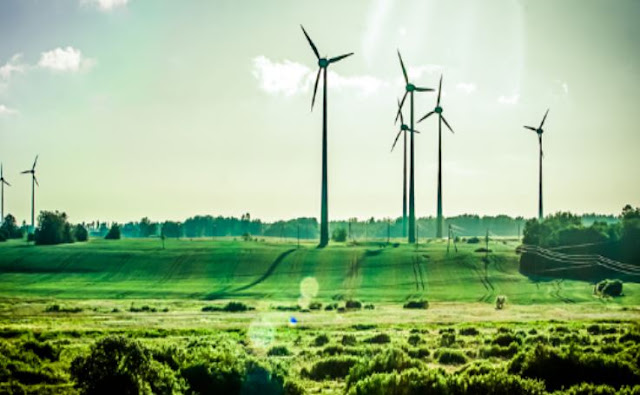Introduction Latest Technology in Renewable Energy
Wind energy is a promising source of renewable energy that has gained significant momentum in recent years. It is a clean and sustainable source of energy that can be used to generate electricity without producing harmful emissions.
Wind turbines are the primary technology used to harness the power of wind energy. They have undergone significant advancements in technology and design, resulting in increased efficiency and output. In this article, we will explore the latest technology in wind energy and its potential to revolutionize the energy industry.
Wind Turbine Technology
Wind turbines are the backbone of wind energy production. They have undergone significant technological advancements, resulting in increased efficiency and performance. Modern wind turbines are larger, taller, and more efficient than their predecessors.
They can generate more electricity at a lower cost and can be installed in a wider range of locations, including offshore. In addition, advanced control systems and sensors can monitor wind speed and direction, adjusting the turbine’s orientation to optimize energy output.
Vertical Axis Wind Turbines
Vertical axis wind turbines (VAWTs) are a newer technology in wind energy. Unlike traditional horizontal axis wind turbines, VAWTs have a vertical rotor shaft and blades that rotate around it. This design has several advantages, including the ability to operate in turbulent wind conditions, less noise pollution, and greater visual appeal. Recent advancements in VAWT technology have resulted in increased efficiency and output, making them a viable alternative to traditional wind turbines.
Wind Energy Storage
One of the biggest challenges of wind energy is its intermittent nature. The wind is not always blowing, which means wind turbines do not always generate electricity. However, recent advancements in energy storage technology have made it possible to store excess wind energy for later use. Batteries, flywheels, and other storage technologies can be used to store wind energy, ensuring a steady and reliable supply of electricity.
Bladeless Wind Turbines
Bladeless wind turbines are a revolutionary technology that eliminates the need for traditional rotor blades. Instead, they use the wind’s vibration to generate electricity. This design has several advantages, including lower maintenance costs, reduced noise pollution, and increased safety. While bladeless wind turbines are still in the early stages of development, they have the potential to revolutionize the wind energy industry.
Offshore Wind Energy
Offshore wind energy has tremendous potential due to the availability of consistent, strong winds. Recent advancements in technology have made it possible to construct wind turbines in deeper waters, further offshore. Offshore wind farms can generate a significant amount of electricity and have the added benefit of being located away from populated areas, reducing noise pollution and visual impact.
Small-Scale Wind Energy
Small-scale wind energy systems are becoming increasingly popular for residential and commercial use. They can be installed on rooftops or in other small spaces, providing a clean and renewable source of electricity. Recent advancements in small-scale wind energy technology have resulted in increased efficiency and affordability, making them a viable option for those looking to reduce their reliance on traditional energy sources.
Wind Energy Forecasting
Wind energy forecasting is an essential tool for wind farm operators. It allows them to predict wind speed and direction, ensuring turbines are oriented to optimize energy output. Recent advancements in wind energy forecasting technology have resulted in increased accuracy and reliability, reducing the risk of downtime and lost revenue.
Hybrid Wind Energy Systems
Hybrid wind energy systems combine wind energy with other renewable energy sources, such as solar or geothermal. These systems can provide a steady and reliable source of electricity, even when the wind is not blowing. Recent advancements in hybrid wind energy technology have resulted in increased efficiency and output, making them a viable option for those looking to reduce their reliance on traditional energy sources.
Key Innovation
Wind energy technology has undergone significant advancements in recent years, resulting in greater efficiency, lower costs, and increased use. One of the most notable advancements in wind energy technology is the development of larger and more powerful turbines.
Today’s wind turbines are taller and have longer blades, allowing them to capture more energy from the wind. This means that fewer turbines are needed to produce the same amount of electricity, reducing the overall cost of wind energy.
Another key innovation in wind energy technology is the use of advanced materials in turbine design. Modern turbines use lighter and stronger materials such as carbon fiber and advanced composites, enabling them to withstand harsh weather conditions while operating more efficiently. This has also resulted in improved durability, reducing maintenance costs and downtime.
In addition to larger turbines and advanced materials, there have been significant improvements in wind turbine control systems. Modern turbines use advanced software to control blade pitch and rotor speed, optimizing energy capture while reducing wear and tear on the turbine. This technology also enables turbines to operate more effectively in varying wind conditions, further increasing their efficiency.
These advancements in wind energy technology have made wind energy a more viable and cost-effective source of renewable energy. With continued innovation and investment, wind energy has the potential to play an even larger role in meeting our energy needs while reducing our dependence on fossil fuels.
https://www.exaputra.com/2023/05/latest-technology-in-renewable-energy_84.html
Renewable Energy
How Should the Measles/Mumps/Rubella Vaccine Be Administered? Should You Ask a High School Baseball Coach?
 There are so many things going wrong in this country simultaneously that it’s hard to list them all.
There are so many things going wrong in this country simultaneously that it’s hard to list them all.
Here’s something that no one could have seen coming: (see short video here) crackpot politicians giving parents insane medical advice about how to care for their children.
If I told you that our country’s parents were making decisions on vaccinating their children based on information provided by figure skaters or lawn mower salesmen, you wouldn’t believe me.
But the case is actually worse; it’s coming from the White House.
Renewable Energy
Do Americans Approve of Our Country’s Execution of Innocent People?
 In this short video on the bombing of ships leaving Venezuela, President Trump asserts that drug overdoses took like lives of more than 350,000 people last year, a figure that, according to the CDC, is actually 79,383.
In this short video on the bombing of ships leaving Venezuela, President Trump asserts that drug overdoses took like lives of more than 350,000 people last year, a figure that, according to the CDC, is actually 79,383.
In any case, the video fails to mention that executing people who have not been charged with and convicted of a crime is a violation of both domestic and international law.
Do Americans Approve of Our Country’s Execution of Innocent People?
Renewable Energy
Why January 6th Wasn’t the End of Trump/MAGA
 Keep in mind that, in 2020, more than 70 million voters cast their ballots for Trump, who, though he is a pathological liar, is 100% trusted by his supporters. When Trump said the election was rigged, the vast majority of these folks believed him. Even today, more than five years later, there are still millions of people who believe there was rampant voter fraud in the election.
Keep in mind that, in 2020, more than 70 million voters cast their ballots for Trump, who, though he is a pathological liar, is 100% trusted by his supporters. When Trump said the election was rigged, the vast majority of these folks believed him. Even today, more than five years later, there are still millions of people who believe there was rampant voter fraud in the election.
Now, is storming the Capitol and beating up/killing law enforcement personnel an acceptable solution? It wouldn’t be for you or me, or most people, but imagine you’re an uneducated white-supremacist MAGA guy, and your president is telling you to do whatever’s necessary to prevent the election from being certified.
These are people who were so desperate to hang Mike Pence that the vice president had to be escorted out of the Capitol building to a secret and secure location, so he didn’t end up at the end of a rope.
When asked about this, Trump replied, “Maybe he deserved it.” To anyone trying to make sense of this, remember that you’re dealing with a deeply disturbed individual, and many millions of truly pathetic people who believe his is an honest and effective servant of the American people. In congress, we have a couple of hundred of the most terrible butt-kissers imaginable, all clamoring to curry favor with him.
-
Climate Change2 years ago
Spanish-language misinformation on renewable energy spreads online, report shows
-
Climate Change3 months ago
Guest post: Why China is still building new coal – and when it might stop
-
Climate Change Videos2 years ago
The toxic gas flares fuelling Nigeria’s climate change – BBC News
-

 Greenhouse Gases1 year ago
Greenhouse Gases1 year ago嘉宾来稿:满足中国增长的用电需求 光伏加储能“比新建煤电更实惠”
-
Greenhouse Gases3 months ago
Guest post: Why China is still building new coal – and when it might stop
-

 Climate Change1 year ago
Climate Change1 year ago嘉宾来稿:满足中国增长的用电需求 光伏加储能“比新建煤电更实惠”
-

 Carbon Footprint2 years ago
Carbon Footprint2 years agoUS SEC’s Climate Disclosure Rules Spur Renewed Interest in Carbon Credits
-
Renewable Energy4 months ago
US Grid Strain, Possible Allete Sale












